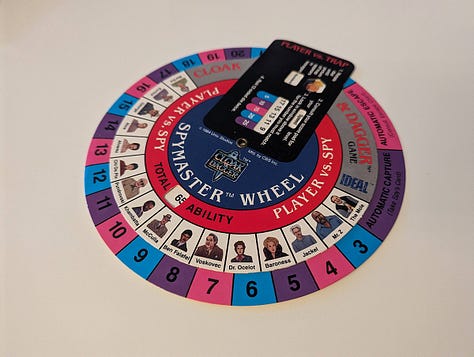Cloak & Dagger the Board Game
When is a role-playing game not a role-playing game?
"Cloak & Dagger," a board game released by Ideal in 1984, occupies a unique space in the world of tabletop gaming. Inspired by the 1984 spy thriller film of the same name, the game attempts to bridge the gap between cinematic storytelling and interactive gameplay. With its intriguing premise, the game captured the imaginations of me and my friends, promising a thrilling experience in the world of espionage.
The gameplay itself is a delicate balance of strategy and chance. From 2 to 4 participants, navigate the game board, each assuming the role of a spy embroiled in a web of missions, enemies, and obstacles. The objective is clear: complete the assigned missions, collect essential items, and avoid adversaries to emerge victorious. The incorporation of cards and dice adds an element of unpredictability, promising that no two games are alike. This blend of strategy and chance not only keeps players on their toes but also allows for dynamic and engaging gameplay sessions for a while.
One of the game's notable quirks lies in its RPG label, a term typically associated with immersive storytelling and character development. However, "Cloak & Dagger" falls short of the traditional RPG experience. While it offers thematic elements inspired by the film, the depth of role-playing found in classic RPGs is conspicuously absent. The game's misclassification as an RPG can be traced back to its cinematic source material.
In the film, the protagonist, Davey, finds solace in a fantasy spy RPG following personal tragedies. His alter ego, Jack Flack, not only exists within the game but also serves as his imaginary friend. This interplay between reality and fantasy blurs the lines, creating a compelling narrative within the movie. The board game attempts to capture this essence by incorporating a 12-sided die, reminiscent of the ones hinted at in the game and the giant dice in his gaming fantasy scene. While this connection to the movie adds a layer of authenticity, it also raises expectations among players, leading to potential disappointment when the gameplay fails to deliver the anticipated RPG experience.
Despite its departure from traditional RPG mechanics, "Cloak & Dagger" does offer a social component through its flexible rules. Players can engage in negotiations, trading items and forming alliances, fostering camaraderie and strategic collaboration. This social dimension enriches the gameplay experience, encouraging players to interact beyond the confines of the game board. However, it is essential to recognize that these interactions, while enhancing the game's social aspect, do not transform it into a full-fledged RPG. We used these mechanics in Monopoly, but none of us would claim that is an RPG.
My personal experience with "Cloak & Dagger" mirrors the sentiments of many players. When I first received the game, I was drawn in by its intriguing premise and cinematic inspiration. Setting it up with friends, we eagerly embarked on our espionage adventures. The initial excitement, fueled by the game's thematic elements, gradually waned as we realized the limitations of its mechanics. It wasn’t exactly a “kids game,” but it was simple enough for most of us to master in about 2 game sessions.
While visually appealing and conceptually intriguing, the gameplay lacked the depth and complexity we expected from an RPG, leaving us with a sense of unfulfilled potential. We just preferred the movie and if we wanted to role-play as spies, better options like Top Secret by TSR were already on the gaming shelf. After about a week of playing it, the game went up on the shelf. The only part of it that ever saw the light of day, was the super cool Jack Flack miniature they included.
Here are a few other photos from my copy of the game. As you can see, it is in pretty good shape due to its lack of overuse.









Despite its shortcomings, "Cloak & Dagger" endures as a testament to the creative experimentation of its time. Its fusion of board gaming and cinematic storytelling paved the way for future movie tie-in endeavors, inspiring designers to explore innovative ways of blending narrative and gameplay. As a collector's item, it might not be extremely valuable, but it serves as a reminder of an era when board games tie-in began to make slightly bolder choices.
Like many things I discuss, "Cloak & Dagger" stands as an interesting relic of the 1980s, offering a glimpse into the ambitious aspirations of game designers and movie marketers. While its RPG label may raise expectations that it cannot fully meet, the game's thematic elements, social interactions, and unique connection to its cinematic source material make it a valuable addition to any board game enthusiast's collection. In the end, my journey with Cloak & Dagger might not have been the epic adventure I envisioned, but I still like it. While it annoyed me when I first got it, I find the RPG confusion is trumped by the game's nostalgic charm. It honored space on my game shelf is a testament to the enduring appeal of vintage board games. So here's to the memories, the adventures, and the Jack Flack miniature that continues to remind me of the magic of the past.





One of my favorite movies as a kid. They should have paid Dabney Coleman for likeness rights because I absolutely would buy this off eBay just to get a mini Dabney Coleman as Jack Flack.
Cool! I remember the movie 👍🤣